A 3in LCD touch screen monitor coupled with face, blink and smile detection make this a fun camera aimed around family time.
GE E1050 TW: Specification
- Zoom: 5x optical (28-140mm)
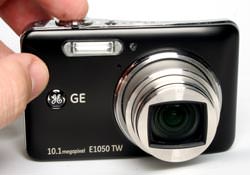 Resolution: 10.1Mp
Resolution: 10.1Mp- Sensor size: 1/2.33in
- Sensor type: CCD
- Image size: 3648×2736
- File type: JPEG
- Sensitivity: ISO80-1600
- Storage: SD, SDHC, internal
- Focus types: Single, multi, face detect
- Normal focusing: 60cm-infinity
- Close focusing: 5cm-infinity
- Metering types: AiAE, centre-weighted, spot
- Exposure compensation: 2EV in 1/3 step increments
- Shutter speed: 4sec-1/2000sec
- Flash: Built in
- Monitor: 3in TFT LCD touch sensitive
- Interface: USB 2.0
- Power: Li-Ion
- Size: 93x58x23.8mm
- Weight: 145g
Prices online average at about £150 and for that you get 10Mp, 5x optical zoom and a touchscreen. You can also look at the Pentax Optio S10 for around the same price which will give you the same resolution, a smaller 3x optical zoom and Pentax’ claim to it being the easiest compact to use.
Alternatively, the Nikon Coolpix S550 at £149 also offers a 10Mp and 5x optical zoom as well as smile and blink detection.
GE E1050 TW: Modes and features
After being pleasantly surprised by the GE G2, I now want to see something special coming from the new contenders in the digital compact market. Those of you who read my history of GE in the 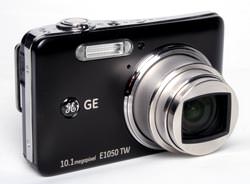 G2 review will know how long they’ve been around for and now they want a piece of the cake that other electronic companies such as Sony, Samsung and Panasonic are enjoying.
G2 review will know how long they’ve been around for and now they want a piece of the cake that other electronic companies such as Sony, Samsung and Panasonic are enjoying.
This offering looks promising on the outside with a trendy oversized lens and touch screen technology. The satin black finish is appealing and the overall it looks to be finished to a good standard.
I was amused how the G2 had GE written twice on the front and they’ve done it again to make sure we can read the company logo properly. The top of the camera houses only the shutter release, power and playback buttons. Everything else is accessed by using the screen on the back.
The good thing about touch screen is that the camera can have a bigger screen but with a smaller body because you don’t need to leave room for all those pesky buttons. Saying that, the E1050 TW isn’t small. In fact it’s quite thick and weighty. Not so bad for someone big and strong like me but younger readers or people with small hands who don’t work out may wish to hold the model before buying it.
Switching on the camera and one thing I notice is that the default volume is loud. So much so that I have to go into the set up menu to turn it down. After about half an hour playing around, I got irritated by the beeps and turned the volume off.
Different features are dotted around the screen so not everything is in the same place which makes it interesting to use. In the top left is a camera icon and pressing this enters a small sub-menu to choose the shooting method such as auto, manual, video and the scenes. The hammer and spanner icon in the top right of the screen is the access to the main menu while the bottom right icon will bring up some extra modes along the bottom of the screen such as self-timer, exposure compensation, ISO and white balance. Continuously pressing this icon also scrolls through the display options popping up features such as a histogram and rule of thirds grid.
 I originally went on the logical approach that any boxes in grey are ones that can access sub-menus but this isn’t strictly adhered to as the resolution can be adjusted by pressing the 10M number in the bottom left corner. The macro and flash modes can also be adjusted by pressing the corresponding icons located to the right of the screen.
I originally went on the logical approach that any boxes in grey are ones that can access sub-menus but this isn’t strictly adhered to as the resolution can be adjusted by pressing the 10M number in the bottom left corner. The macro and flash modes can also be adjusted by pressing the corresponding icons located to the right of the screen.
The blink detection feature works by flagging up a big black box in the middle of the screen with red lettering stating that a blink has been detected. You can then quickly retake the photograph.
In the modes menu, the auto mode will clip some of the modes you’d use in manual so that they aren’t available. This is the ideal mode for those of you who aren’t that bothered about histograms and exposure compensation. You can also choose from the scenes, panoramic mode which merges three images taken consecutively. These images are taken by swivelling around by your waist or using a tripod and panning. If you’re going left to right, the left of the screen will show a ghosted portion of the previously taken shot in the left of the frame to help you align.
 The panoramic image is created by stitching three pictures taken consecutively. Slight distortion can be seen because of the wide angle view of the lens. |
There are a few other features that the E1050 TW offers that GE aren’t shouting about. Amazingly the camera has HD output yet this is only mentioned in passing on the website and in the instruction manual. Other companies are trumpeting the news yet GE let it slide. Similarly, red-eye removal is a software based feature that actively seeks and eliminates red-eye from an image which is a really useful feature and seems to be overlooked for the touch screen capability.
A 5x optical zoom is housed in the E1050 TW’s body and this has a widest setting of 28mm which is great for landscapes and also boosts the performance of the panoramic stitching mode.
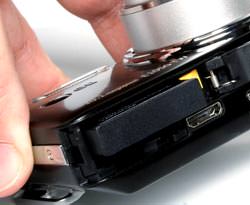 The battery bay holds the Li-Ion battery and SD card. Shown in this shot is the exposed HDMI output. |
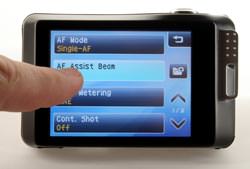 The touch screen is responsive enough and is well built. |
GE E1050 TW: Build and handling
I’m really impressed with the build quality of the E1050 TW especially with a metal casing which helps if it’s accidentally dropped. That doesn’t mean not to be careful though as all it takes is a slight knock the wrong way to dislodge some wiring inside of any camera.
Gripes with the build are the battery door being really flimsy and the HDMI output being exposed. The USB port has a cover so I’m unsure why they left the premium port open to the elements. Not only that but it’s on the bottom of the camera meaning all sorts of debris will go into when it’s put down. Not good thinking on GE’s part.
Of course the main point of focus here is the touch screen and I’m pleased to say that it’s nicely responsive and doesn’t need hard taps for it to register. I’ve seen some touch screens where the touch sensitive layer sits a millimetre or so away from the actual screen. This creates a kind of cushion feeling as the trapped air is displaced with the pressure of your finger. While this screen does have a softness to it, that’s just the touch sensitive layer that works on pressure so needs a degree of depth to register you touching it.
When I took the camera outside in the sunshine to take the portrait images, I had a really hard time seeing the screen because of the touch screen layer which has a reflective sheen to it.
GE E1050 TW: Performance
I remember my first foray into the world of GE cameras with the G2. I wasn’t overly impressed with the shutter lag of that camera as it was more than twice as slow as a standard compact. The E1050 TW is variable with a response of between 0.15 and 0.25 seconds. This is better than the G2 in some respects but fails at the lower end.
There are four contiuous shooting modes to choose from in the drive tab. The unlimited mode simply keeps taking pictures and can manage 11 shots in ten seconds with a further four seconds to download.
You can also choose from 3shot, 3shot (last) and time-lapse. Time-lapse works by setting a particular time span and the camera will take a photograph at each one of the set intervals.
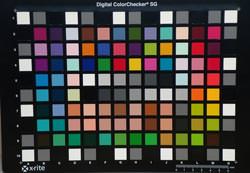 The colours are nicely saturated and the mono tones are evenly balanced except the black which could be blacker. |
I like the colours that the E1050 TW has produced on the colour test chart. The primary colours have been pushed up to make them stand out and all other colours give a comfortable result. The only thing I’m unhappy with is the black. It could be blacker but the rest of the mono tones are evenly balanced. I also think the skin tone is good so the portraits should be a doddle.
As I used the camera thoughout these tests, I had to keep it as still as possible yet this seemed to be one of the most difficult things I’ve had to do.
The tripod bush is located at the far end of the camera meaning it has a tendency to move when the shutter release is pressed and this could cause problems with focusing. The quick release plate was tightened up as far as I could do it and yet the camera still span around. This means that the camera isn’t flush with the plate.
The reason behind this is four raised dots on the mould for the tripod bush. I think it’s designed to grip to the plate but is in fact a hindrance.
One of the features seen more on compacts these days is colour styles. It’s a feature that either boosts or desaturates colours in the image. It can also turn an image black & white or sepia. The GE E1050 TW has natural, vivid, black & white and sepia to choose from. The mono options are simply gimmicky and they can’t replace the versatility of making the changes on a computer. The vivid mode does have a distinct difference and I’ve illustrated them below so you can see the difference.
 The natural colour image. |
 The vivid colour image. |
 The landscape image suffers from over sharpening in an attempt to disguise the shallow depth of field. |
It was a rainy day when I took the landscape image but I struck lucky with a break in the clouds when I got there. The image looks really badly over sharpened. This could be due to the fact that the camera has used an aperture of f/3.7 to make sure a tripod isn’t needed. It’s started to throw the background out of focus and the sharpening will attempt to keep everything in. Looking at the lettering on the balance beam, it’s broken up and distorted because of the effect of processing.
Fringing isn’t bad on the white bars but the camera can’t cope with the leaves under the sky with purple bleeding over onto the green. I like the green of the grass and also the detail in the blades which is due to the sharpening I think.
Earlier I mentioned that the skin tone tile on the colour chart is a nice colour and there shouldn’t be any problems with the colour of the portraits. The normal portrait has come out to a reasonable standard although cropping in to full size will show more of that annoying sharpening at work.
The flash image has kept the image at a great exposure but with shadows filled in nicely. It’s let down by the obvious colour cast which is really unfortunate.
 The portrait image. |
 The portrait with flash. |
As I took the images, I kept noticing that I got a message popping up all the time stating that the file was going to be overwritten. This is because the file number extensions renew whenever the card is erased. Because I took the images over a number of days, I would download the images off the card and it would be clean for my next shoot.
Potentially this can cause problems if you’re not sure what it means and just simply click yes, you’ve just deleted a load of photographs. My tip would be to go into the set up menu (press the hammer and spanner icon on the screen then tap the folder in the top right corner), look for the option named file numbering and change it to continuous. This will mean that the file number that the camera allocates to your picture will continue to rise.
 Face detection on the GE E1050 TW stops working if the subject is any closer to the edge of the frame than this shot. |
GE E1050 TW: Focus and metering
Apart from the face detection, focusing is automatic and pretty much just targets on the centre. In the manual mode, you can choose from single or multi AF, but this doesn’t allow you to choose the focus point or anything. In fact I still couldn’t get it to move from the middle.
The GE E1050 TW has three metering modes which are the usual modes found on any camera. AiAE is a fully auto mode similar to multi metering or pattern. It takes a reading from different areas of the frame, works out the best exposure from the analysis and sorts out the aperture and shutter speed from the results. Centre-weighted metering takes a general reading from the whole area and is susceptible to under exposing if it gets confused by bright areas of an image.
Finally, spot metering takes a reading from the exact centre of the frame ignoring everything around it which can give some really interesting results in the right situation.
GE E1050 TW: Noise test
Results of the noise test are unusual to say the least. There’s detail in the images and they’re sharp enough, but they still don’t look right. Maybe it’s the custom white balance sending the flower petals a reddish colour instead of the orange that they are. Maybe it’s the noise creeping in at low ISO that’s annoying me.
I’m disappointed to see the noise especially at ISO100. It’s only very slight and can only really be seen at full size but it’s there nonetheless.
I would say that it’s a good thing that the ISO is capped at 1600 because it starts to get pretty unbearable even by ISO400. The processor has tried to dampen the issue by using sharpening to keep detail in the petals but it only serves to exaggerate the problem at the top end.
GE E1050 TW: Verdict From a feature set point of view, the GE E1050 TW appears to be well thought out. It’s a shame that the image quality isn’t all that good. Manufacturers seem so obsessed with giving us sharp images that they’ll over process them in a bid to win our hearts.
From a feature set point of view, the GE E1050 TW appears to be well thought out. It’s a shame that the image quality isn’t all that good. Manufacturers seem so obsessed with giving us sharp images that they’ll over process them in a bid to win our hearts.
The trouble with the noise is the sensor is quite small. Stuffing 10Mp on to a 25mm square chip is asking for trouble. The problem is that sometimes what you ask for is what you get.
I actually quite like the camera but I’d like to see a better quality of picture coming from it. As a consumer I’d be happy with what features it has but as a photographer, I can’t accept the image quality.
If you want your camera with a minimum of buttons but with plenty of features and you’re bowled over by gimmicks such as a touchscreen, then this is a camera to take a look at.
GE E1050 TW: Plus points![]() Touchscreen works well
Touchscreen works well![]() Well built camera
Well built camera![]() Good zoom
Good zoom![]() Wide angle lens
Wide angle lens
GE E1050 TW: Minus points![]() Bad noise
Bad noise![]() Exposed HDMI port
Exposed HDMI port![]() Tripods can’t sit flush
Tripods can’t sit flush
FEATURES![]()
HANDLING![]()
PERFORMANCE![]()
OVERALL![]()
The GE E1050 TW costs around £150 online and is available in a range of pretty colours. Take a look at the General Imaging website here for more information.